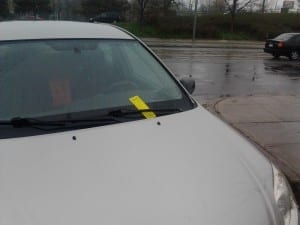Afterwards: Contemporary photography confronting the past (2011)
Afterwards is edited by Nathalie Herschdorfer, a photography historian and curator.
In pictures and texts, this book explores the evolving conventions of documentary photography.
Research suggests that our brains are not wired for comprehension of events involving thousands or millions of people.
Our brains are better wired to comprehend events through our aquaintance with the experiences of one or a handful of people.
In this book I would have preferred a larger text size and shorter paragraphs for the texts at the back of the book. The text size and line spacing in the main part of the book, however, work well.
Texts that are easy to read, and thus easier to comprehend than would otherwise be the case, warrant commendation.
History is what has occurred prior to the present moment
What happened a second ago is history.
A local parking bylaw officer wrote the following account of history on April 15, 2012: “Park signed highway in excess of permitted time.”
The account was placed on the windshield of a car, as the photo indicates, outside Woody’s Burger Bar and Grill on Lake Shore Blvd. West in Etobicoke, Ontario.
I recently wrote up a Gem of the Lakeshore nomination for Woody’s Burger, along with one for Fair Grounds, the coffee shop across the street from it. I’ve written many such nominations for independent businesses along Lake Shore Blvd. West from Long Branch to Mimico.
Aside from nominations for local recognition awards, and parking tickets, community letter writing projects offer another great way to engage in conversations related to local history.
That is one of many things that I learned in the course of the 2011 Parkview School project.
Jane’s Walks, Heritage Walks, and Heritage Bike Rides are also great ways to share history.
Sometimes, we seek to celebrate history.
At other times, however, we deal with events from the past that need to be confronted. Rather than dealing with celebration, we sometimes deal with confrontation.
The subtitle for Nathalie Herschdorfer’s book is: Contemporary photography confronting the past.
The ‘museumification’ of memorial sites
I’ve chosen several items to focus upon in this blog. One is a series of photographs by Léa Eouzan of France. She addresses Auschwitz — ‘symbol of all of the 20th century internment, concentration and extermination camps of Europe’ — in its current role as a museum featuring a bar, cafeteria, and shop.
The photographer focuses “on the way in which history is prepared and manipulated for consumption” (p. 158).
In 1944, Lithuanina was taken over by the Soviet Union
The occupying Soviet forces, as an overview (pp. 54-57) of the work of Indre Serpytyte explains, ran centres of interrogation, detention, and torture in towns and villages across Lithuania.
These places looked like ordinary houses.
Indre Serpytype asked a wood sculptor — this form of art having a long tradition in Lithuania — to make models based on photographs she had taken of these centres of interrogation, detention, and torture.
She requested that the wood be not hollowed out in any way.
The solid blocks were set against a neutral background and photographed from a distance.
The ‘Claymore’ antipersonnel directional fragmentation mine releases 700 steel balls
Raphaël Dallaporta of France has photographed antipersonnel mines in a studio. He has also photographed sites associated with domestic slavery.
The antipersonnel mines are reproduced life-size. The mines that are depicted in the photographs cover fifty years of conflict.
Tom Ridgway (apparently mispelled as Ridgeway in the book) has written captions detailing dimensions, weight, country of origin, method and scale of destruction for these mines.
On p. 163 (and also on view at the photographer’s website) is a photograph of a Claymore mine. On the surface of the device are embossed capital letters specifying: “FRONT TOWARD ENEMY.”


Leave a Reply
Want to join the discussion?Feel free to contribute!